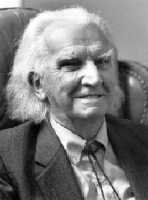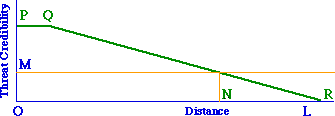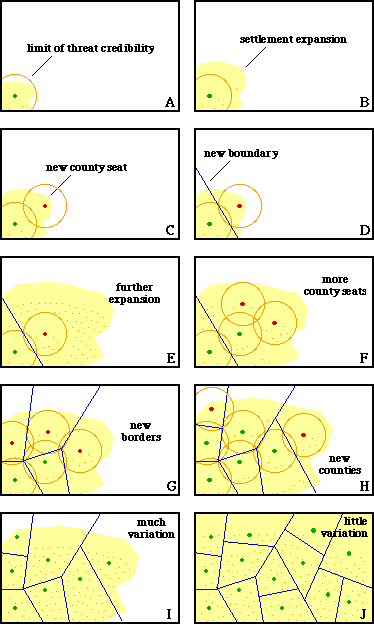CHAPTER 3
Modeling County SubdivisionAs the natural limit of a democracy is that distance from the central point which will just permit the most remote citizens to assemble as often as their public functions demand, and will include no greater number than can join in those functions; so the natural limit of a republic is that distance from the centre which will barely allow the representatives to meet as often as may be necessary for the administration of public affairs. Can it be said that the limits of the United States exceed this distance? It will not be said by those who recollect that the Atlantic coast is the longest side of the Union, that during the term of thirteen years, the representatives of the States have been almost continually assembled, and that the members from the most distant States are not chargeable with greater intermissions of attendance than those from the States in the neighborhood of Congress.While I was studying the origins of Lane County I looked through many of the earliest county records; most were written in elegant, faded, Spencerian script. A recurrent theme in these records was the problem of distance. It was difficult to get someone to assess property and collect taxes in outlying areas. As a result the state complained frequently of the county's falling behind in its "tax effort" — the percent delivery on taxes anticipated by the government at Salem. Citizens complained about a lack of services outside Eugene (the seat), and commissioners argued about whether to pay people for jury duty if significant travel or overnight stays were involved.
Imagine a seat of government located on a featureless plane. In Fig. 3-1 the government's location is O and its nominal jurisdiction extends to the distance L. Its threat credibility has a given level at O and suffers little or no loss a small distance from O (the sheriff can shoot you just about as easily a block away as he can at his doorstep). Beyond some point Q it takes effort to move threat capability, so threat credibility begins to decline. At some point R it falls to zero.
At some point threat credibility declines below a critical value M beneath which government regulations will not be enforced. The distance beyond this NL, whatever the government's claim, is "bush", "wilderness" or "frontier".
This presents no problem so long as the frontier remains empty, but as settlers move in they escape government's ability to enforce laws. They also are without governmental services. One solution to this problem is to move the seat of government, as shown in Fig. 3-3. This happened many times in the western settlement of the United States. There were even "county seat wars" in which government (or at least its files and records) was forcibly removed from one site and taken to another. Though a war is more dramatic than a peaceful relocation to occupy a frontier, it amounts to the same thing: a power vacuum becomes filled.
One difficulty with this solution is that moving the seat too far simply creates frontier elsewhere, as in Fig. 3-4. The county seat "stolen" from one location was often stolen back to its equally distant original site.
Furthermore, institutions don't move easily. As the seat of government accumulates records, offices and other material goods, it becomes expensive to move. A simpler solution to the frontier problem is creation of a second seat of government to serve the newly settled region, as in Fig. 3-5.
Overlapping boundary claims can, of course, can lead to war at the international level. At the subnational, county level the problem is solved by drawing a boundary, border in Fig. 3-6. The state government which creates the boundary effectively drops the threat credibility of each local government at the border (with possible exceptions for such things as "high speed chase" or extradition).
While solving the frontier problem, such subdivision also reduces the size of the original county. A long series of such subdivisions would produce a pattern similar to that observed in Oregon: the so-called size-distance relation with smaller counties in the area of earlier settlement (ordinarily the site of state capital). If the state becomes completely settled, the counties would be uniformly small and the size- distance relation would disappear. The above assumes constant transportation technology. Moving "too far" is after all a function of what "far" means in the first place. Unlike their western movie counterparts, real sheriffs in the Old West may not have wanted to ride horseback, camping overnight, to obtain taxes sixty miles away; but a modern one with a car can do that fairly easily. Fig. 3-7 show this extension of governmental threat credibility assuming such a change in transportation. A horse can travel 15-20 miles per day; an automobile or truck can cover 250-600 miles.[3] For the extremes (i.e., from 15 to 600 miles), distance is reduced by a factor of 40. [4]
Fig. 3-8 illustrates the model proposed here for a hypothetical state. Initially the population is well within the limits of the local government's ability to govern. In 8-B the settlement area has expanded beyond that limit, creating the need for a new seat (8-C) with the subdivision boundary (8-D). Expansion continues (8-E) and new counties are created (8-F:H). If transportation technology remains constant and expansion continues, the result is the set of uniformly small counties shown in 8-J. If technology improves sufficiently, no new divisions are needed and the result is variation in county size as shown in (8-I).
The size-division model seemed reasonable and certainly matched what I had been able to observe in Oregon and infer in several other states. But reasonableness isn't the same thing as proof. Did present day counties actually emerge as this model suggests? My doubts were reinforced when another letter arrived from the Chief of the Geography Division, Bureau of Census (informing me of his continued inability to locate historical county maps). In this letter he stated that "for whatever it is worth to you, it is our opinion that the location of county boundaries is more political than demographic-ecologic".
NOTES: * My thanks to Dr. Ronald E. Rinehart, Department of Atmospheric Sciences and Joanne Irene Gabrynowicz, Professor of Space Law & Policy, University of North Dakota, for bringing Madison to my attention in this context. [1] Kenneth E. Boulding, "The City as an element in the international system." Daedalus, 97:1111-23. 1968. [2] Arthur L. Stinchcombe. Constructing Social Theories. New York: Harcourt. 1968. [3] Amos H. Hawley, Human Ecology: a Theory of Community Structure, 352, New York: Ronald Press Company, 1950. [4] It is hard to imagine the pre-automobile sense of distance under which our ancestors lived. In many of the larger counties, a trip to the county seat meant staying overnight. No wonder local government was so important and the national government was so weak. |









